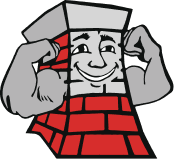What You Can Do About a Blocked Chimney
When we talk about chimney blockages, we’re usually talking about obstructions that exist within the flue, as opposed to blocks at either end of the chimney. When a chimney flue is blocked, several things can happen that you most definitely want to avoid. National Chimney Cleaners of Fairfield County, CT, and Morris County, NJ, would like to share some helpful information about what you can do if your chimney is blocked.
 Why do chimneys become blocked and obstructed?
Why do chimneys become blocked and obstructed?
There are four primary causes of chimney blockage. They include:
1. Tree debris
2. The nesting materials of small animals such as birds and squirrels
3. Dead small animals
4. Excess creosote and soot
Anything that narrows the flue passage is a blockage and can cause the fireplace to draft poorly. When this happens, dangerous smoke and carbon monoxide can back up into the home. Smoke contains a variety of toxic gases, but carbon monoxide is the most problematic. Invisible and odorless, it has been shown to cause severe respiratory illnesses and even death when inhaled in sufficient amounts.
How material gets into a chimney
Materials from outside the house – tree debris and the nests of small animals – get in through the top of a chimney that isn’t protected by a chimney cap.
The simple act of having a custom full-width chimney cap installed will keep all this debris out of your chimney flue and prevent these kinds of blockages. Your chimney can also become blocked by a buildup of creosote and soot. Creosote forms when smoke condenses in the flue. It can appear as a puffy, sticky or solid substance. In all forms, it’s highly flammable and is the #1 cause of chimney fires throughout the U.S. each year. Over time, creosote and soot can narrow a flue to the point that the wood in the fireplace doesn’t have enough incoming air to burn efficiently. This blockage can also send smoke and carbon monoxide into your home, as noted above.
The best way to remove chimney obstructions
Most homeowners don’t have the tools or training to remove stubborn creosote, leaves, twigs, animal nests and the occasional dead animal from their chimneys. Professional chimney sweeps are equipped for this job, and this is who you should call for all chimney cleaning projects. Chimney sweeps use special rods, chains, brushes, solvents and other “tools of the trade” to safely remove debris and creosote from your chimney. It’s recommended that you schedule this service once a year, whether or not you have a blockage.
 The best way to prevent some obstructions
The best way to prevent some obstructions
Your chimney sweep can install a proper chimney cap at the top of your chimney. Chimney caps not only keep debris out, but they also do a good job of containing flying sparks and embers that sometimes jump out of the tops of chimneys.
Keep your chimney running safely and efficiently
Throughout Morris County, New Jersey, and Fairfield County, Connecticut, homeowners turn to National Chimney Cleaners for regular and emergency work on their chimney and fireplace systems. If your chimney is obstructed, we’ll get it back into shape quickly. If it’s damaged, we’ll get it fixed the right way.
Speak with a chimney expert today at (631) 821-0051 or get in touch with our handy contact form.


